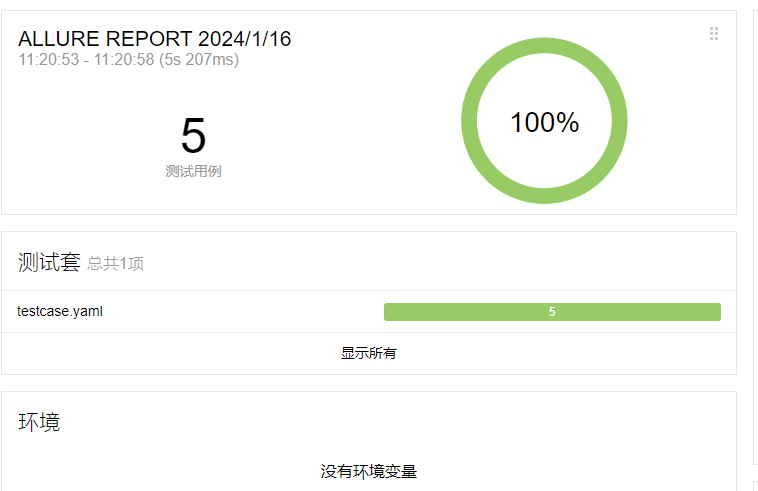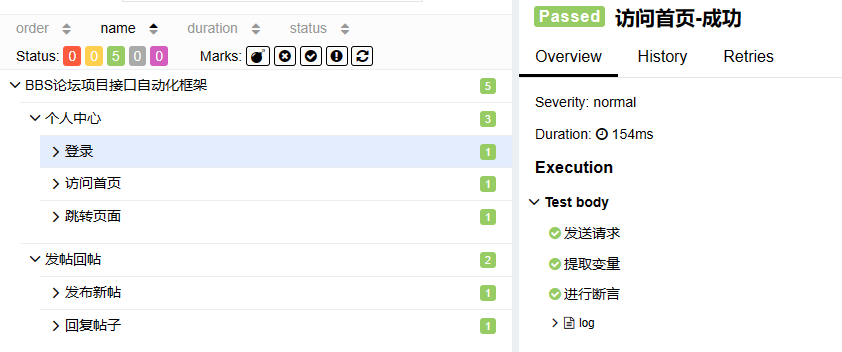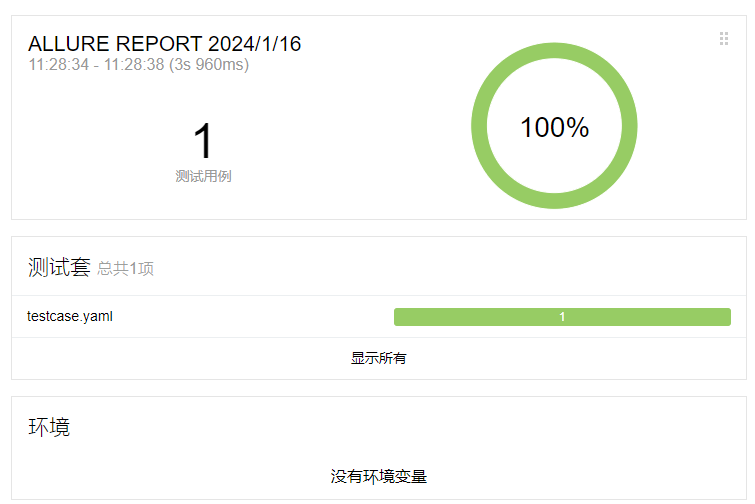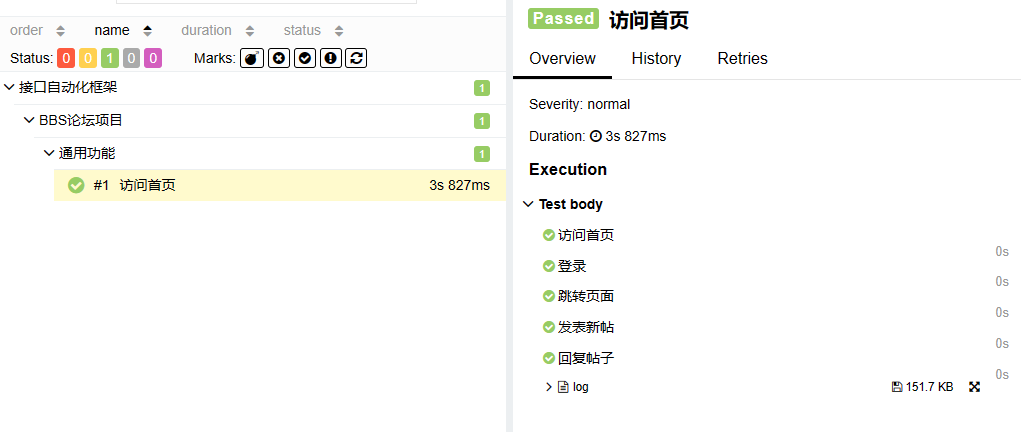python接口自动化框架零代码极限封装之流程用例和DDT数据驱动
1.流程用例
1.1 什么是流程用例
工具:
- postman
- jmeter
每个接口就是一个用例,称之为单接口用例
自动化:
- pytest
- unittest
- yaml
每个用例,可以包含多个接口,称之为流程用例
需要多个接口配合才能完成
例子:
- 微信上传功能:
- 获取token
- 上传文件
- 商城购物功能
- 选择商品加入购物车
- 提交订单
- 在线支付
- 确认收货
- 商品评论
1.2 流程用例该如何实现
在python中,在用例中继续增加测试步骤,即可增加接口请求,完成流程用例
1 def test_abc(): 2 resp=session.get('https://www.baidu.com') 3 4 resp=sessiom.get('https://qq.com')
在yaml中,在用例中继续增加测试步骤,即可增加接口请求,完成流程用例
1 test_name: 访问首页 2 3 steps: 4 - request: 5 method: GET 6 url: http://www.baidu.com 7 8 - request: 9 method: GET 10 url: http://www.qq.com
单接口用例报告


流程用例报告


用例直接彼此隔离
多个单接口用例 vs 一个流程用例
- 单接口用例可以筛选用例,可能导致部分用例没有机会执行
- 流程用例可以打包接口,确保所有接口一起请求
- 业务关系
- 测试报告
2.数据驱动测试
python原生支持参数化测试,配合数据文件(json,yaml),轻松实现数据驱动测试
yaml零代码极限封装,本身就是yaml数据文件,原生支持数据驱动测试
2.1 复习pytest中参数化测试
1 import pytest 2 3 4 @pytest.mark.parametrize( 5 "n", # 参数 6 [ 7 1, 2, 3 # 一组数据,分别修改参数 8 ] 9 ) 10 def test_abc(n): 11 print(n) # 使用参数
多个参数
1 import pytest 2 3 4 @pytest.mark.parametrize( 5 "x,y", # 参数 6 [ 7 [1, 3], 8 [2, 4], 9 [5, 8] 10 ] 11 ) 12 def test_abc(x, y): 13 print(x, y) # 使用参数
重点:
- 使用注解parametrize
- 注解中提供参数
- 用例中使用参数
- 传递列表数据[1,2,3]
2.2 改造成数据驱动测试
1 import pytest 2 import yaml 3 4 5 # data=yaml.safe_load(open("data/ddt.yaml",encoding="utf-8")) #加载数据 6 7 # print('data',data) 8 9 10 @pytest.mark.parametrize( 11 "x,y", # 参数 12 yaml.safe_load(open("data/ddt.yaml", encoding="utf-8")) 13 ) 14 def test_abc(x, y): 15 print(x, y) # 使用参数
2.3 yaml用例使用参数化
重点:
- 使用注解parametrize
- 注解中提供参数
- 用例中使用参数
- 传递列表数据[1,2,3]
1 test_name: test_abc 2 3 mark: 4 - parametrize: 5 keys: 6 - n 7 vals: 8 - 1 9 - 2 10 - 3 11 steps: 12 - request: 13 method: get 14 url: https://www.baidu.com/?wd=${n}
多个参数
1 test_name: test_abc 2 3 mark: 4 - parametrize: 5 keys: 6 - x 7 - y 8 vals: 9 - [1,2] 10 - [3,5] 11 - [6,8] 12 steps: 13 - request: 14 method: get 15 url: https://www.baidu.com/?wd=${x}-${y}
2.4 yaml用例加载数据文件
1 test_name: test_abc 2 3 mark: 4 - parametrize: 5 keys: 6 - x 7 - y 8 vals: !include ddt.yaml 9 steps: 10 - request: 11 method: get 12 url: https://www.baidu.com/?wd=${x}-${y}
!include不是pyyaml标准命令
如果单纯编写yaml,谨慎使用
!include加载文件途径:
- 绝对路径
- 相对路径,相对于谁
- 测试用例本身:支持上级目录,也支持下级目录
3.DDT项目实战
对同一个接口需要反复传参,反复测试的场景中
经典场景:
- 登录
- 账号正确
- 账号错误
- 空参数
- 查询数据
- 存在的数据
- 不存在的数据
- 空参数
- 组件参数
- 地址:三级联动(省市区)
3.1 创建普通的单个用例
1 test_name: 获取微信token 2 3 steps: 4 - request: 5 method: GET 6 url: https://api.weixin.qq.com/cgi-bin/token 7 params: 8 grant_type: client_credential 9 appid: wx0f6d68f21b3e5fde 10 secret: 3b0740791899c3ec2a97dec67f134afc 11 #提取变量 12 # token=(res.json(),'access_token')[0] 13 # token:变量名 json:数据来源 access_token:jsonpath 0 结果索引 14 - extract: 15 code: [status_code,(.*),0] 16 expires_in: [json,expires_in,0] 17 18 #断言 19 - validate: #断言 20 equals: 21 状态码等于200: [ '${code}' , 200 ] #相等 22 有效期等于7200: [ '${expires_in}' , 7200 ]
3.2 构建数据,作为参数传递
[ ['wx0f6d68f21b3e5fde','3b0740791899c3ec2a97dec67f134afc',7200], ['1245678899123','3b0740791899c3ec2a97dec67f134afc',None] ]
1 test_name: 获取微信token 2 mark: 3 - parametrize: 4 keys: 5 - appid 6 - secret 7 - my_expires 8 - my_errcode 9 vals: 10 - ['wx0f6d68f21b3e5fde','3b0740791899c3ec2a97dec67f134afc',7200,no_data] 11 - ['1245678899123','3b0740791899c3ec2a97dec67f134afc',no_data,40013] 12 13 steps: 14 - request: 15 method: GET 16 url: https://api.weixin.qq.com/cgi-bin/token 17 params: 18 grant_type: client_credential 19 appid: ${appid} 20 secret: ${secret} 21 #提取变量 22 # token=(res.json(),'access_token')[0] 23 # token:变量名 json:数据来源 access_token:jsonpath 0 结果索引 24 - extract: 25 code: [status_code,(.*),0] 26 expires_in: [json,expires_in,0] 27 errcode: [json,errcode,0] 28 29 #断言 30 - validate: #断言 31 equals: 32 状态码等于200: [ '${code}' , 200 ] #相等 33 有效期等于7200: [ '${expires_in}' , '${my_expires}' ] 34 错误代码: ['${errcode}','${my_errcode}']
分类:
python接口自动化测试
标签:
自动化测试




【推荐】国内首个AI IDE,深度理解中文开发场景,立即下载体验Trae
【推荐】编程新体验,更懂你的AI,立即体验豆包MarsCode编程助手
【推荐】抖音旗下AI助手豆包,你的智能百科全书,全免费不限次数
【推荐】轻量又高性能的 SSH 工具 IShell:AI 加持,快人一步
· 震惊!C++程序真的从main开始吗?99%的程序员都答错了
· 别再用vector<bool>了!Google高级工程师:这可能是STL最大的设计失误
· 【硬核科普】Trae如何「偷看」你的代码?零基础破解AI编程运行原理
· 单元测试从入门到精通
· 上周热点回顾(3.3-3.9)